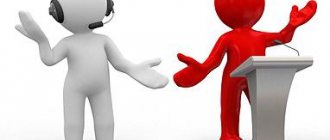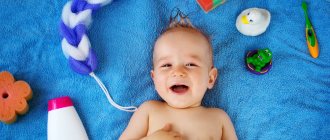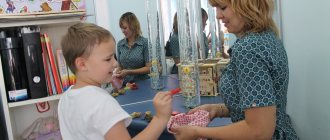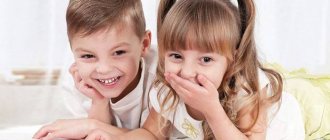Vocabulary is the number of words that a person understands and uses in speech. Moreover, he uses some of them, but not the other. Thanks to speech, we communicate with each other, expressing our thoughts and conveying them to our interlocutor, forming beliefs and developing intellectually. The richer, more literate and expressive a person’s speech is, the higher his level of education and cultural development is considered.
The lexical dictionary of children and adults consists of two categories:
- Active vocabulary is words that a person uses regularly in speech and writing.
- Passive vocabulary - consists of words that a person knows and perceives by ear, but does not use himself. Significantly exceeds the active dictionary.
There is no exact answer to what an adult’s reserve should be. For example, the dictionary of V.I. Dahl contains more than 200 thousand words, the academic dictionary of the Russian language - approximately 130 thousand words, the latest edition of the dictionary by S.I. Ozhegova – 70 thousand words. Obviously, even the most erudite people do not speak such a volume of vocabulary. According to the latest research data, an adult’s active vocabulary ranges from 5 thousand to 35 thousand words, passive - from 20 thousand to 100 thousand words.
Online tests help you check your vocabulary and evaluate it. But the results for the same person over different periods of time may differ, since he is constantly developing - he learns new words, but at the same time forgets or stops using previously learned ones.
As a rule, people with a rich vocabulary have more prospects, achieve goals faster, and achieve success in their careers, management, and show business. According to the majority, their work is more interesting, creative, extraordinary, and their achievements are higher. The same applies to your personal life. A person with a large vocabulary better formulates his thoughts, verbalizes desires and emotions, and due to this, he better finds a common language with people.
Vocabulary can be compared to a snowball: the more complex concepts a person knows, the more new words and terms he is able to perceive, remember and use in his speech. This is why it is necessary to develop a child’s speech from early childhood.
How do the first words come about?
Every mother eagerly awaits her baby's first words. As a rule, all relatives are involved in the waiting process: mom, dad or grandma - which word will come first? Usually, the winner in this fight is the one who most often stands over the child’s crib, looks carefully into his eyes and clearly repeats: “pa-pa” or “ma-ma.” As a result, the child pronounces the cherished word, and the whole family celebrates the historical event! The child is bathed in applause, and he, satisfied, continues to babble the magical sounds that have caused so many positive emotions in adults. If you continue in the same spirit - look into the child’s eyes, clearly pronounce new words and just as emotionally rejoice at each new one - you will certainly be surprised at the dynamics of your baby’s speech development.
“Why exactly “dad”, “mom” and “baba”? The sounds that make up these words are classified as labiolabial and labiodental. They are formed with the help of lips and voice and are easiest for a child. In order for the baby to also easily develop front-lingual, mid-lingual and back-lingual sounds, add the “horse” exercise: click happily with him,” explains Olga Ivanova.
Physical development of a child at 3 years old
The development standards of a child at the age of three are the following skills:
- the child can independently go up or down the steps, alternating legs;
- actively runs and jumps;
- catches and throws the ball;
- independently climbs a hill and slides down it;
- maintains balance while standing on one leg;
- rides a tricycle confidently;
- can step over or jump over obstacles lying on the floor;
- imitates the actions of his peers (runs, jumps, crawls).
A three-year-old baby is very physically active, so he can already be enrolled in a sports section, swimming pool or dancing. In this way, he will be able to get rid of excess energy and at the same time improve his physical development.
Don't forget about exercises that you can do at home. The child will have fun doing various simple exercises with his mother.
For example, you can do the following exercises:
March on the spot.
“Stretch” - the child raises his arms above his head and stretches upward.
Jumping on two legs in place.
“Flap your wings” - the child stands straight in place, then spreads his arms to the sides, raises them up, and then lowers them down.
The exercises will be much more interesting if you combine them with music and singing songs.
What is active and passive vocabulary?
All the words that a child knows are his vocabulary (lexicon). Moreover, those words that the baby understands, but does not pronounce himself, belong to the passive dictionary. And those words and phrases that are constantly used in everyday speech are included in the active one.
Olga Ivanova: “For example, if you ask a one-year-old child “where is the cat?” and he points to the pet or the corresponding picture with his finger, which means the word “cat” is already in his passive dictionary. When he independently says “cat”, or “koska”, or any other sound that means a cat for a child, we can say that the word has become an active lexicon.”
It is worth noting that the passive vocabulary is always larger than the active one, even in an adult.
After all, each of us knows what society, quantum, molecule are, yet we almost never use these words in everyday speech.
Educational games
A child’s knowledge of the world occurs through games. How can you expand your vocabulary through games?
- "Edible-inedible." Game for children from 3 years old. The presenter (or mother) throws the ball to the child and names the object. If it can be eaten, the baby catches the ball; if the object is inedible, there is no need to catch the ball. You can change the conditions of the game, for example, the participant must catch the ball if the leader calls something soft.
- "Who is bigger". A good game that you can play, for example, in line or on the way to kindergarten. We come up with a category of words, for example, pets. We name domestic animals in turn: dog, cat, cockerel, chicken, cow, etc. The one who remembers the most pets wins. By the way, in this game the mother can give in a little so that the baby feels like a real winner.
- "Children's crocodile." The child chooses some thing or toy, but does not tell the other participants what he chose. Then the baby must describe the chosen item in words, but cannot name it. Then the players change places.
- “Selecting antonyms.” You tell the child a word, and he must choose an antonym: night-day, sun-moon, heaven-earth, evil-good, crying-laughing, etc.
- "Fact or fiction?" You offer your child fictitious or real statements, and his task is to agree with you or find errors. For example, a dog is bigger than an elephant, chickens eat semolina, a dog loves a bone, etc.
The task of parents is to help their son or daughter develop competent, rich speech. To do this, you need to constantly talk with the child, expand his vocabulary, read books, and offer educational games. The more you work with your child on speech development, the easier it will be for him to learn, work and express his thoughts in the future.
leave a comment
How to calculate the volume of active and passive vocabulary?
Finding out the approximate number of words in a passive dictionary is easy. It is enough to ask the child to show a certain object, action, object (for example, a cat). If the child did everything correctly, then the word is counted in the passive dictionary.
Now let’s calculate the size of the active dictionary. What should you consider?
- Words that the child pronounces clearly: “give”, “mom”, “dad”.
- Onomatopoeia for animals and objects: car “beep-beep”, dog “woof-woof”.
- Reproduction of incomplete words: “baka” - dog.
- Words that are pronounced incorrectly, but the number of syllables and stress are correct: “patina” - machine.
- Words that are pronounced the same, but have different meanings (this is the norm up to 2.5 years): “ma” - mom, car, meow (each word is counted separately).
“To make it easier to count active vocabulary and clearly see the progress and dynamics of a child’s development, you need to keep a diary of speech development. Every month you can enter the words that your child has mastered. From 2.5-3 years old, keeping track of every word will be quite difficult due to the growing talkativeness. Then you can write down the baby’s funny sayings in your diary, which you will be happy to re-read in the future,” the speech therapist advises.
Sources
- Yoldaş TÇ., Özdemir G., Karakaya J., Özmert EN. Turkish validation of the maternal responsiveness global rating scale in slow-to-talk toddlers. // Turk J Pediatr - 2021 - Vol62 - N5 - p.802-811; PMID:33108083
- Pacheco LDRA., Miguel JHS., Gil D. Musical stimulation proposal for hearing impaired children: case reports. // Codas - 2021 - Vol32 - N5 - p.e20190139; PMID:33053089
- Costa B., White P., Kiff JD., Davies A., Stock NM. Parent-reported socioemotional and cognitive development in children with a cleft lip and/or palate at 18 months: Findings from a UK birth cohort. // Child Care Health Dev - 2021 - Vol47 - N1 - p.31-39; PMID:32990944
- Jutras B., Lagacé J., Koravand A. The development of auditory functions. // Handb Clin Neurol - 2021 - Vol173 - NNULL - p.143-155; PMID:32958169
- Babatsouli E. Measuring word-final consonant clusters in developmental child speech. // Clin Linguist Phon - 2021 - Vol35 - N5 - p.419-437; PMID:32683994
- Venker C.E., McDaniel J., Yasick M. Speech-Language Pathologists' Ratings of Telegraphic Versus Grammatical Utterances: A Survey Study. // J Speech Lang Hear Res - 2021 - Vol63 - N7 - p.2271-2280; PMID:32579870
- Skovlund E., Selmer R., Skurtveit S., Brandlistuen RE., Handal M. In utero exposure to analgesic opioids and language development in 5-year old children. // Pharmacoepidemiol Drug Saf - 2021 - Vol29 - N6 - p.736-744; PMID:32383248
- Thistle JJ., Wilkinson KM. Speech-Language pathologists' decisions when designing an aided AAC display for a compilation case study of a beginning communicator. // Disabil Rehabil Assist Technol - 2021 - Vol - NNULL - p.1-9; PMID:32228265
- Babatsouli E. Correlation between the measure for cluster proximity (MCP) and the percentage of consonants correct (PCC). // Clin Linguist Phon - 2021 - Vol35 - N1 - p.65-83; PMID:32223449
- Macari S., Milgramm A., Reed J., Shic F., Powell KK., Macris D., Chawarska K. Context-Specific Dyadic Attention Vulnerabilities During the First Year in Infants Later Developing Autism Spectrum Disorder. // J Am Acad Child Adolesc Psychiatry - 2021 - Vol60 - N1 - p.166-175; PMID:32061926
How many words should a child have in his active vocabulary?
The norms for the formation of the active vocabulary of a child of preschool and primary school age are as follows:
Thus, if a child normally pronounces no more than 10 words per year, then a child’s vocabulary at 3 years old is already about 1000 words. The vocabulary of a 5-year-old child is already about 2000 words, and the vocabulary of a 6-year-old child is about 3500 words. Don't panic if you suddenly find that your child is speaking fewer words than normal. Each child is individual and develops at his own pace. There are children who begin to speak closer to 2 years, but understand everything already at 1-1.5 years.
If you still have doubts or questions about your baby’s development, for your own peace of mind, consult a specialist. Good dynamics are provided by the inclusion of fun games to develop vocabulary, as well as finger exercises and palm massage. Positive emotions play a very important role: going to the zoo, water park and spending creative time together with parents.
Development of vocabulary
A child’s lexical development consists of two aspects:
- Quantitative growth of vocabulary;
- Qualitative development – mastering the meanings of words.
In preschool age, the child’s vocabulary is enriched quickly. The period of speech development from 1 to 6 years is considered sensitive (sensitive) and the most successful for learning, favorable for the influence of the external environment. But the speed greatly depends on the environment in which it is located, so data on the number of words of preschoolers of the same age differ.
Let us consider the sensitive period of speech and vocabulary development in more detail.
Replenishment of a child’s vocabulary by year
In the first year of life, a child needs emotionally positive communication with adults for normal speech development.
The child learns words in such conditions when he can correlate the visual image of an object and its sound. If at this time he has the opportunity to manipulate the object (twist it in his hands, taste it), the new word will be remembered faster. For example, a mother gives the child a spoon and shows him what to eat with it.
By the age of one year, he uses only 5-9 words like “give” and “yum-yum”, correlates them with objects and actions, and develops reactions to the word. This is a preparatory stage for mastering speech.
At this age, it is already worth paying attention to enriching the child’s vocabulary. Regular and systematic classes will allow your child to grow up erudite and intellectually developed.
It is important under what conditions a child’s speech is formed and developed. It is best for others to speak correctly and slowly, since children at this age imitate adults. If a child hears incorrect speech, the wrong images of words are fixed in him, which is difficult to correct in the future.
1-1.5 years – hypersensitive phase, rapid accumulation of passive vocabulary and the beginning of the formation of the phonetic and grammatical aspects of speech. But if verbal communication is not enough, the emerging speech is quickly destroyed. Symptoms: delay in the appearance of the first words, “forgetting” already familiar words, stoppage of speech development.
At this age, objective and effective communication with adults begins. Passive vocabulary is rapidly expanding to 800-1000 lexical units. It consists of words used by parents in communicating with each other and with others.
By one and a half to two years, attention to the articulation of adults intensifies, the child repeats (echolalia) and pronounces certain words himself. It is normal if at this age he confuses sounds, distorts, rearranges or skips them.
The first words have a generalized semantic character - i.e. the same word can denote an object, an action, and feelings. You can understand a child in a situation, which is why such speech is called “situational”.
At one and a half years old, a child can distinguish in a photograph where dad is, where mom is, where grandma is, and where a brother or sister is, names and shows parts of the body (nose, mouth, eyes, etc.).
2.5-3.5 years – formation of phrasal speech. The transition to an abstract form of thinking, from monosyllabic phrases to complex structures. From the age of 3, the formation of the grammatical structure of speech begins. The child begins to construct sentences from primitive phrases that are not consistent with each other, coordinating and subordinating words.
During this period, there was a significant expansion and accumulation of vocabulary. The most common data on the quantitative growth of vocabulary in children:
- 1.6 – 10-15 words;
- end of 2 years – 300 words;
- 3 years – 1000 words.
From the age of 3, a child perceives everything through play. During this period, he consciously names objects and points to them with gestures, pays attention to color, shape, size, certain qualities of objects and phenomena, and also understands the difference between the words “one” and “many.”
What a 3 year old child should know:
- what are the names of family members, loved ones, pets;
- names of toys (pyramid, doll, ball, car, puzzle, etc.)
- names of dishes and cutlery (plate, spoon, fork, bowl, pan)
- names of clothes (jacket, dress, jeans, T-shirt, shorts, etc.);
- names of food products consumed in the family;
- spatial concepts (left, right, bottom, top);
- simple geometric shapes (circle, square, rectangle, triangle, star)
- names of animals and their young (hen-chick, dog-puppy, cow-calf, sheep-lamb).
- at least 5-10 plant names;
- names of seasons and weather phenomena (rain, snow, wind, sun, moon).
A 3-year-old child's vocabulary development is based on memorizing the meanings of nouns and verbs. Since at this age children cannot describe an object or their state using words, there is no point in focusing on adjectives and adverbs. At this age, it is enough to know the names of some sensations and states (warm, hot, cold, painful, tasty).
By the age of 3, a child develops “inner speech.” It becomes a means of his intellectual and speech development. He constantly involves an adult in the process of communicating with himself. Any mental stress and sensory deprivation at this age can provoke delayed speech development and lead to speech pathology (stuttering, mutism, speech negativism).
It is normal if a child at this age makes pauses not only between individual phrases, but also in the middle of words (this is dysrhythmia of a speech utterance, which indicates the intensive formation of intraspeech programming). Also, repetitions of words, combinations and even syllables (physiological iterations) appear in speech. An important component of speech during this period is speech breathing (the child can begin to speak in any phase of the respiratory act). It happens that in the process of speaking, the vegetative system actively reacts - the child blushes, feels tension in the muscles, and breathes quickly.
3.5-5 years – full understanding of adult speech, instructions, speech becomes a means of communication.
Children 3-5 years old learn to use certain words by repeating after adults, as well as in the process of interacting with the objects they talk about. In the vast majority of cases, the child attaches a literal meaning to spoken words. For example, the word “friendship” will be learned literally by a 5-year-old child: we play together, we walk hand in hand. Only after 11 years, according to Piaget's theory, does he begin to understand that friendship is based on trust, mutual assistance, common interests, etc. (since at the same time he begins to understand such abstract concepts as trust, betrayal, mutual benefit).
At this age, the child has many questions like “Why?”, “Why?” etc. Also at this age, children master generalization (a dog is not only a toy at home, but also a drawing in a picture, a neighbor’s pet). Particular attention should be paid to the formation of sound pronunciation, as disturbances in the pronunciation of whistling, hissing and sonorant sounds may occur.
At 4 years old, a normotypical child uses mostly simple sentences, but also confidently constructs compound and complex sentences. At this age, he is able to compose a story of 40-50 sentences without the help of adults, which indicates mastery of monologue speech.
The highest stage of word integration occurs, since the child’s brain already contains the result of previously acquired knowledge, and generalizations appear. At this age, children often name the category of an object rather than the object itself, which complicates the process of understanding for their parents.
The volume of the dictionary is 1900-2200 words. New thematic groups and categories that children of this age master:
- understanding and expression of feelings and emotions (joy, fun, anger, anger, resentment);
- characteristics of objects (size, color, temperature);
- diminutive forms of words (mommy, bush, fox).
At this age, the child fully understands how a word is formed. Therefore, he develops the skills of creating groups of words with the same root by adding prefixes and suffixes: mouse - little mouse, drink - drank. At the same time, he understands the differences between words with the same root from the same group: a cat is a large animal, and a kitten is a small cub of a cat.
After five years, there is also a sharp jump compared to the previous period - the number of words doubles, the vocabulary is 3000-4000 words. The number of lexical units increases sharply due to precisely the same root words: “cat-cat-cat-kitten”, “bucket-bucket”. The meanings of words are further enriched and clarified, but the child can still use them inappropriately.
At the age of 5-6 years, the skill of relating a new word not to one object, but to many appears. When learning new words at this age, children sometimes do not realize the full meaning of their content, so there is an erroneous use of words, a narrowing and expansion of the boundaries of their meaning and application. This happens because they fluctuate between concrete and abstract experience (before this, they were absolutely sure that only what they see exists).
This is also the period of formation of contextual speech, i.e. The child himself comes up with a monologue and voices it. He launches a very complex mechanism for the transition of internal plans into external speech. The central nervous system is most tense at this age, as at 3 years old.
During the period of 5-7 years, “failures” of speech breathing occur when using complex phrases and long pauses due to difficulties in forming a lexico-grammatically correct statement. Monologue speech may not be sufficiently formed due to mental stress and limitations of communication in the natural environment.
An important stage in speech formation in preschool age is word creation. The child himself comes up with new words, taking familiar nouns or nouns and verbs as a basis. For example, he may call his hand “nose bag” from “carrying a bag.”
Topics that a child aged 5-7 understands:
- time and intervals (hour, minute, week, year), seasons;
- using numerals using grammar (five chairs, third apple);
- names and surnames of family members, prominent personalities (favorite musical performers, cartoon characters);
- names of attractions and holidays;
- the concept of space (horizon, sky, space, Universe, around the corner, in another city);
- colors and shades, professions and sports, body parts of people and animals;
- vehicles, household items;
- wild animals, exotic plants and trees, fruits, vegetables, flowers;
- words denoting emotions and their evaluations (positive, negative).
The older the child, the less dependent he becomes on the sensory situation. The semantic content of words gains strength only towards the end of middle preschool age due to the assimilation of new knowledge about the world around us. Also during this period, children develop an aesthetic attitude towards words and speech. For example, at the age of 5, children can use metaphors, but they do this consciously only from high school age.
At the end of middle preschool age, the acquired language becomes truly native to the child.
From the age of 6-7, reading is important for a child’s education. This is the time when he already has a fairly large stock of knowledge about the world in which he lives, and the skills of inventing, composing and showing creativity are actively developing. At this age, reading is a source of emotional experience for children and contributes to their mental and speech development. The task of an adult is to instill in children a love of reading instead of watching cartoons and videos on YouTube, and to explain that a book (written language) is a source of knowledge.
When children enter school, testing is required to determine the level of their speech development. To avoid learning problems, it is recommended to first assess your child’s vocabulary and fill in existing gaps.
Where can I get new words?
This, of course, is communication with parents and other close adults, and then added communication with other children. Interesting games and activities are also important - by expanding our horizons, we expand our vocabulary. What does it mean? At a very young age, every new sensation is recorded by a newly created neural connection in the baby's brain. Over time, everything that he has already learned and will snatch from the world around him in large quantities will begin to be reflected in words. Family traditions and holidays, walks and fairy tales.
“Everything around can become a source of enrichment for a growing person’s vocabulary. The main condition here is that the parent explains, names and shows. And in the future, he answered numerous questions,” explains Olga.
New sensations
Firstly, everything is tactile. Finger paints and various surfaces. Pet fur and rough tongues, sea and sand, pebbles and acorns, spruce branches and food. Plasticine and constructor. This is an inexhaustible source. And also sounds, smells and everything, everything, everything: music and new songs, for example, lullabies. The tastes of food and the smells of flowers - all this gives rise to new connections, new thoughts and requires words, stimulating the child.
Books, stories and games
Parents who read fairy tales and poems, invent nursery rhymes and sing songs are very helpful parents. Enthusiastic grandmothers, aunts, and older brothers and sisters also get involved. It is advisable to choose poems that are age-appropriate, and books with bright and clear pictures.
Travel and dating
Even if the baby just looks at everything and gurgles, new places and people will still awaken the dormant spirit of the explorer in him. The main thing on such trips is to tell and show the child everything, to let them touch what is interesting. And don’t be upset if a brick fence arouses more enthusiasm than a local landmark.
Brothers and sisters
In a large family, younger children usually speak better and start talking earlier because they often interact with older brothers and sisters.
Emotions
Find something that your child likes. A dog, a kettle and a slow cooker with lights, a pair of mom’s rubber boots - if a person is delighted, then you’re doing everything right. And it’s not far from the storm of emotions to its verbal expression.
Developing vocabulary in children
From an early age, parents need to make efforts to ensure that the child’s vocabulary is constantly replenished with new names and concepts. What can be done for this?
- Read books. With the help of stories and fairy tales, we expand the child’s horizons, teach him to perceive new information, fantasize and dream. For example, a child will be able to see a live toucan or giraffe only in a zoo, but with the help of a book he will get acquainted with new animals, birds, and learn a lot of interesting things about them. For small children, buy books with bright, colorful illustrations. You can purchase publications with tactile pictures that your baby can touch with his fingers. Talk about everything the child sees in the picture: “Look what a beautiful farm! Where is the cockerel? And the chicken? Show me the pig, please."
- We talk more. From birth, pronounce your actions: “Now I’ll change you, and we’ll go for a walk,” “Mom will cook delicious porridge, and we’ll have breakfast.” While walking, tell your baby about trees, flowers, buildings. At home, name all the objects you pick up: toys, clothes, food, etc. Constantly talk to your child, use synonyms, and monitor the emotional coloring of your speech. Show the entire emotional palette of words so that the baby understands how mom feels when she explains or says something.
Is learning languages good for speech?
Early learning of languages helps the development of a child’s speech if this process brings joy to parents and the baby. Therefore, you need to switch to the foreign language that you like best and know best.
Bilingual children begin to speak earlier from birth if both parents actively communicate with them.
“I often compare learning a second language to learning to swim,” Olga explains. If a child begins to master this activity at 3–4 months, then by the age of three he will already be able to swim perfectly independently. Then you can start teaching him how to ski, say. And if you start swimming at the age of three, then, of course, this process will take much longer, and parallel training in different sports can cause certain difficulties. It’s the same with languages.”
First six months
By the end of 1 month of life, a healthy baby already responds to treatment: it stops crying and focuses on the adult. At 3 months , when communicating with an adult, the baby becomes animated and “hooks.”
Vowel sounds predominate, as well as the consonants g, k, n. At 5 months, the baby reacts to the direction of sound, “sings”, changing the intonation of his voice. By 6 months, the first syllable “ba” or “ma” appears. An initial understanding of addressed speech arises: the child listens to the adult’s voice and recognizes familiar voices.
Balance of active and passive vocabulary, or why develop speech?
A passive dictionary will always be larger in volume than an active one. At the same time, we should strive to achieve a balance between dictionaries, that is, try to use as many words as possible that we know in everyday speech. And teach this to our children. For what?
In modern society, people who can speak well and interestingly, with developed oratory skills, are valued. The ability to express one’s thoughts clearly and beautifully, captivate the audience, and win the interlocutor to one’s side will help the child in school, in communicating with peers, and throughout life. In addition, an increase in vocabulary entails the development of intelligence, memory, attention, imagination and perception.
A child with a rich vocabulary communicates more easily with adults and other children, and accordingly, adapts better in society. It is easier for such children to learn poetry, solve logical problems, create, and, in general, realize themselves.
What to do if the child does not speak? Read about the signs that should alert parents.
Share your story: when did your child start talking and what was his first word?
- share with your friends!
Experts: Olga Ivanova
Second year of development
2 years . The child shows five parts of the body, has a vocabulary of at least 50 words; understands and correctly follows two-step instructions (“go to the kitchen and bring a cup”), correctly uses the pronouns I, you, me. By the age of two, the child has already mastered the sounds: p, b, m, f, v, t, d, n, k, g, x. He usually skips or replaces whistling sounds (s, z, ts), hissing sounds (sh, zh, ch, shch) and sonorant sounds (r, l).
2 years 6 months . The child understands the designation of actions in different situations (“show who is sitting, who is sleeping”), the meaning of prepositions in a familiar specific situation (“what are you sitting on?”). Pronounces sounds correctly: s, z, l, repeats two numbers in the correct sequence, has the concept of “one”.








